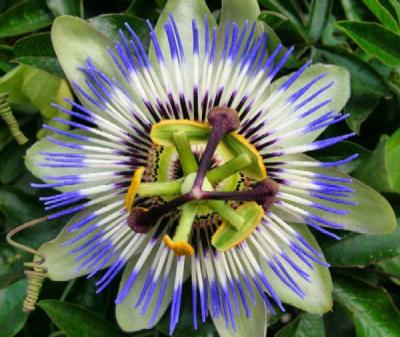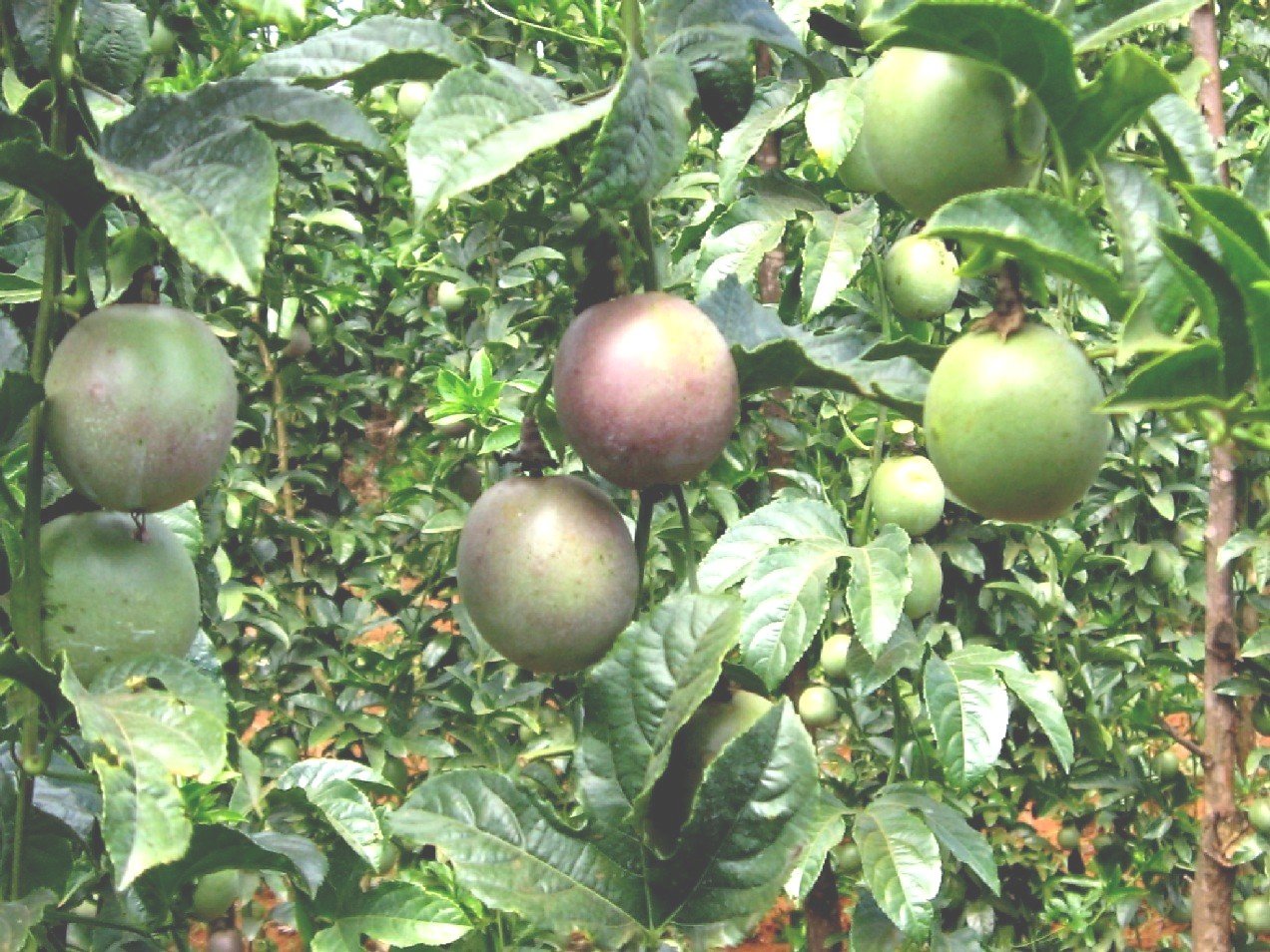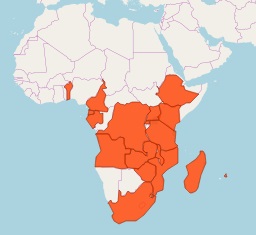Credits: Biovision-Infonet

(c) A. M. Varela, icipe

(c) Courtesy EcoPort (http://www.ecoport.org): J. Breithaupt

(c) Courtesy EcoPort (http://www.ecoport.org): B.French

(c) A.A.Seif, icipe
Scientific Name: Passiflora edulis (purple passion fruit) / P. edulis var. flavicarpa (yellow passion fruit)
Order / Family: Violales: Passifloraceae
Common Names: Maracuya
Pests & Diseases: Aphids, Broad or yellow tea mite, Brown spot, Bugs , Fruit flies, Fusarium wilt, Leafmining flies (leafminers), Mealybugs, Phytophthora blight, Root-knot nematodes, Septoria spot, Spider mites, Woodiness potyvirus
Geographical Distribution in Africa

General Information and Agronomic Aspects
Passion fruit is a native of southern Brazil where it grows on the edges of rain forests. There are two distinct forms: forma edulis, the purple passion fruit, occurs in cool environments at higher altitudes, and forma flavicarpa, the yellow passion fruit, which is at home in the tropical lowlands.
The two types were distributed throughout the tropics and subtropics via Europe and Australia during the 19th century.
The passion is a perennial climbing plant, which was introduced into Kenya in the 1920’s. It is now a popular fruit for both domestic and export markets. From 2001 to 2005 export from Kenya of passion fruit was around 1,000 tons per year, against a total production of around 30,000 tons yearly.
The fruit may be eaten fresh, but mostly the pulp is extracted and preserved by heating or cooling. The juice has a unique and intense flavour and high acidity, which makes it a natural concentrate.
When sweetened and diluted it is very palatable and blends well with other fruit juices.
Typical processed products are ice cream, sherbet, nectar, juices, concentrate, squash, jams and jellies. Passiflora plants are often cultivated as ornamentals for their showy flowers.
Passion flowers are widely employed by herbalists and natural health practitioners around the world today.
They are mostly employed as a sedative, hypnotic (inducing sleep), nervine, anti-spasmodic and pain reliever.
Climatic conditions, soil and water management
The yellow passion fruit grows best at altitudes of 0-800 m and is used mainly for the fresh fruit market. It can also be used as a rootstock for grafting of the purple variety; the purple passion fruit forms virtually no flowers below 1000 m and should be grown at altitudes of 1200-2000 m.
The mature purple passion fruit tolerates light frosts and can be grown in the subtropics.
Other varieties exist such as the so-called banana passion fruit growing in highland areas and often climb very tall trees. It is yellow at maturity but with soft velvety skin and pink flowers quite different from the commercial passion fruits.
The banana passion fruit is mainly used in sweetened juices, as it is not usually very sweet on its own.
All varieties grow on a wide range of soils; but light to heavy sandy loams, of medium texture and at least 60 cm deep are most suitable. Heavy clay soils have to be drained and very sandy ones need heavy manuring.
A pH of 5.5-7 is preferred. If the soil is too acidic, lime must be applied. Good drainage and aeration are essential to minimise the incidence of diseases such as collar rot.
Purple passion fruit, especially, grows well on as little as 900 mm rainfall in Africa, provided the rainfall is well distributed.
The vines require sheltered locations without extreme temperatures: Optimum temperatures for the purple variety are between 18-25degC and for the yellow variety 25-30degC.
Critical temperatures were established for hybrid cultivars in Australia as follows: below 20degC pollen does not germinate and at 18-15degC both growth and flowering are set back, whereas temperatures above 30-32degC stimulate growth at the expense of flowering and fruit set (CABI).
Passion Fruit Types
There are two main forms of the passion fruit, the purple and the yellow varieties, with the yellow being distinguished as P. edulis var.flavicarpa. Hybrids can be made between purple and yellow passion fruit, which yields intermediates between the two forms.
Principal characteristics of the yellow type:
- Yellow rind and larger fruit
- More acid flavour
- Flowers are self-sterile – wind is ineffective because of the heaviness and stickiness of the pollen. They must be pollinated, and carpenter bees are the most efficient pollinators.
- More vigorous vine
- More tolerant of frost
- Resistant to nematodes and Fusarium wilt
- Brown seeds
Principal characteristics of the purple type:
- Purple rind and smaller fruit
- Sweet less acidic pulp richer in aroma and flavour and has a higher proportion of juice (35-38%)
- Can self pollinate but pollination is best under humid conditions
- Less vigorous vine
- If crossing yellow and purple types, it is necessary to use the purple parent as the seed parent because the flowers of the yellow are not receptive to the pollen of the purple, and an early blooming yellow must be utilised in order to have a sufficient overlapping period for pollen transfer. These crosses have some ability to withstand ?woodiness? virus.
- Black seeds
Varieties
Names and Characteristics of some Commercial Passion Fruit Varieties
| Variety Name | Origin and Characteristics |
| Australian Purple or Nelly Kelly | Mild sweet flavour |
| Common Purple | Naturalised Hawaiian variety. Thick skinned with small cavity |
| Kapoho Selection | A cross of yellow Hawaiian strains. A heavy bearer but subject to brown rot. |
| Black Knight | Purple cultivar |
| Bountiful Beauty | Purple cultivar |
| Sevcik Selection | Golden form of the yellow, a heavy bearer but subject to brown rot. |
| University Round Selection | Hawaiian cross small fruit and not attractive but high juice yield. |
| Nelly Kelly | Australian purple cultivar |
| Waimanalo Selection | Consists of four strains, C-54, C-77, C-80 of similar size, shape and colour and C-39 as a pollinator. |
| Nancy Garrison | Purple cultivar |
| Yee Selection | Yellow, round, attractive and highly disease resistant. |
| Ester | Very large purple fruit ? variety imported as large passion fruit. |
| Purple Giant | Purple cultivar |
| Kahuna | Very large medium purple fruit good for juicing and produces over a long season |
Propagation and planting
Passion fruit is generally propagated from seed, although cuttings and grafting can be used. Seed should be rubbed clean of pulp and dried in the shade. Germination takes 2-4 weeks.
Fresh seeds are much easier to germinate than seeds older than one or two months. Older seeds can be soaked for at least one day to improve germination. Seedlings are often raised in polythene bags, 15 cm wide and 25 cm deep.
Three seeds per bag are sown at a depth of 1 cm and thinned to leave one after two months. Cuttings are set in coarse sand and later transplanted into bags or a nursery bed.
The seedlings grow slowly and require 3-4 months to reach the transplanting height of 15-25 cm. Seedlings must be hardened off by leaving them in an open, shaded area for a day or two.
Grafting is often used to control diseases.
Yellow passion fruit is used as resistant rootstock although other Passiflora species, in particular P. caerulea L., show much greater resistance to Phytophthora root rot and Fusarium collar rot. Moreover, P. caerulea is tolerant of root-knot nematodes and to exposure to -1.5degC; it can be propagated from leaf and stem cuttings and is compatible with P. edulis.
Wedge and whip grafts on seedling rootstocks – sometimes on rooted cuttings – are used.
Within 5-7 weeks after transplanting, each plant will have up to four healthy laterals. From then on the vine grows very rapidly; the first flowers are produced 5-7 months after transplanting when the vine can be 10-15 m long.
Light is the essential factor for flowering and in passionfruit this is particularly true for floral development and fruit set.
That is why training and pruning are important to ensure adequate exposure of the shoots.
Depending on the climate there may be one to three harvest peaks (purple passionfruit) or a single, often very long harvest season (more common with the yellow passion fruit).
Land preparation
Deep ploughing and harrowing is necessary to remove hard pans in the soil. Passion fruit has a deep root system; therefore proper land cultivation is necessary.
Commercial plantations adopt a row spacing of 1.2-1.8 m and a within-row spacing of 3 m. This gives around 1,900 – 2,700 plants/ha. Planting holes of 45 x 45 x 45 cm should be filled with topsoil mixed with up to 10 kg of compost or manure.
Transplanting is done at the start of the rainy season.
At planting the soil around the plants should be firmed down to establish good root/soil contact. In order to avoid fungal infection the grafting spot should not have any contact with the soil during and after planting.
The seedling should then be irrigated to ensure quick rooting and establishment of the plant.
Husbandry
Early growth of passion fruit is slow and regular weeding is essential. Care should be taken when weeding in order to avoid any injury to the plant. Mulching along the rows or around the base of the plants greatly facilitates weed control and protects the roots.
Elaborate trellises have been used in Australia and South Africa, but in East Africa, especially at closer spacing, a single wire trellis has been found to be as good.
A 14-gauge galvanized wire is tightly stretched along the tops of hardwood posts 15 cm in diameter and 3 m long, dug in to a depth of 0.6 m; these posts are spaced 8 m apart.
The trellis should be erected when the field is planted so that the main shoot and one vigorous lateral can be tied to the wire with a string.
If laterals do not emerge in time, they can be forced to leaf out by pinching off the shoot tip. When the vines reach the wire they are trained in opposite directions along it.
All laterals below the wire are pruned off. Laterals emerging along the wire are allowed to hang down freely; they are the secondary shoots branching into tertiary shoots.
Secondary and higher-order shoots are the fruiting wood, which has to be thinned and rejuvenated by pruning.
Regular fertilisation is necessary for optimum yields. Frequent sprays with compost tea or similar organic foliar feed should be applied starting from 1 month after planting and at least every 3 months after that. Mixing EM or BM with foliar sprays may prevent fungal attacks.
Pruning
Old unproductive shoots and dead wood must be removed. Also secondary shoots reaching the ground must be cut off about 5 cm above the ground.
The laterals which bear fruit should be left to hang down freely from the wire and the entangling tendrils removed to allow free air and light penetration and reduce incidences of disease and pest epidemics.
Disinfect with commercial detergent all equipment used for pruning regularly to avoid spread of viral diseases.
Intercropping
A wide range of vegetables and other crops can be intercropped with passion fruit. Intercropping with annuals is recommended; especially vegetables like beans, cabbages and tomatoes are agronomically suitable.
Other recommended crops include potatoes, beetroots, Swiss chard, carrots, spinach, strawberries, eggplants, peppers, onions, leeks and head lettuce.
However, cucurbits (cucumbers, pumpkin, and squashes) are not recommended due to the woodiness virus and fruit flies.
Other crops that should not be intercropped with passion fruits are maize, cowpea, sorghum, okra, sweet potatoes and other creepers (GTZ, 1978). Intercropping can help in erosion control particularly when fed with good compost.
Rotation
To avoid build up of soil-borne diseases strict crop rotation should be practised (see suitable crops under intercropping).
Passion fruits should not be grown for more than 2-3 years on the same plot.
Yield
If a plantation is cropped for 3 years; of the total crop, roughly 50% is produced in the first year, 35% in the second, and 15% in the third year.
The sharp decline in yield level, which is even more marked in areas with disease problems, is the main reason to replant fields after the second or third crop.
Average yields amount to 10-15 t/ha per year for the purple and 20-25 t/ha per year for the yellow passion fruit.
Much higher yields are possible; yields as high as 50 t/ha per year for purple passion fruit have been reported from Kenya.
Harvesting
Fruit drops to the ground when fully mature. It is collected every second day; at this stage it looks shrivelled and unattractive, but for processing fruits should be picked at this stage.
For fresh fruit markets, especially the export market, fruit is picked after full colour development when the whole fruit is purple or canary yellow, but before shrivelling and drying set in.